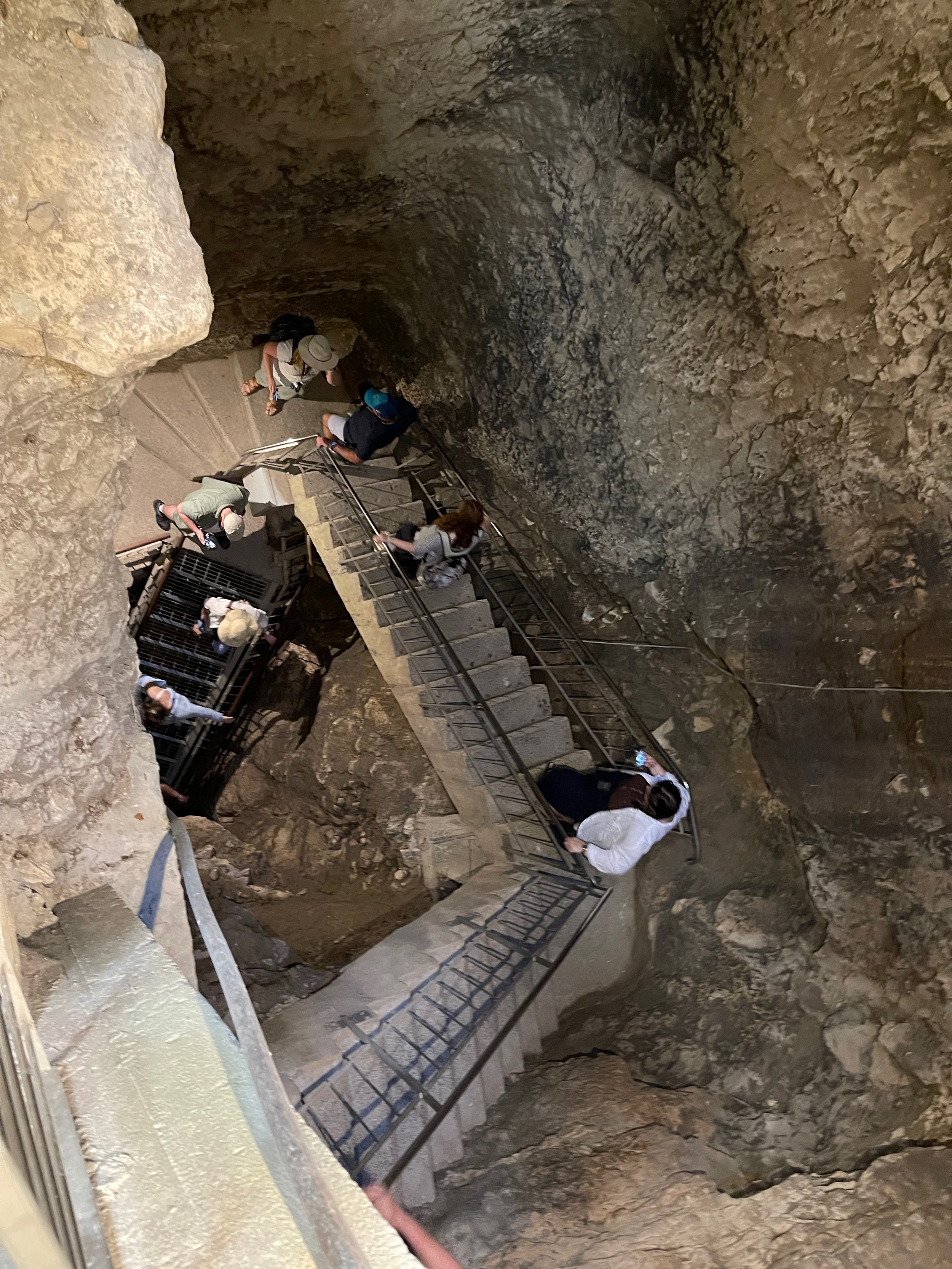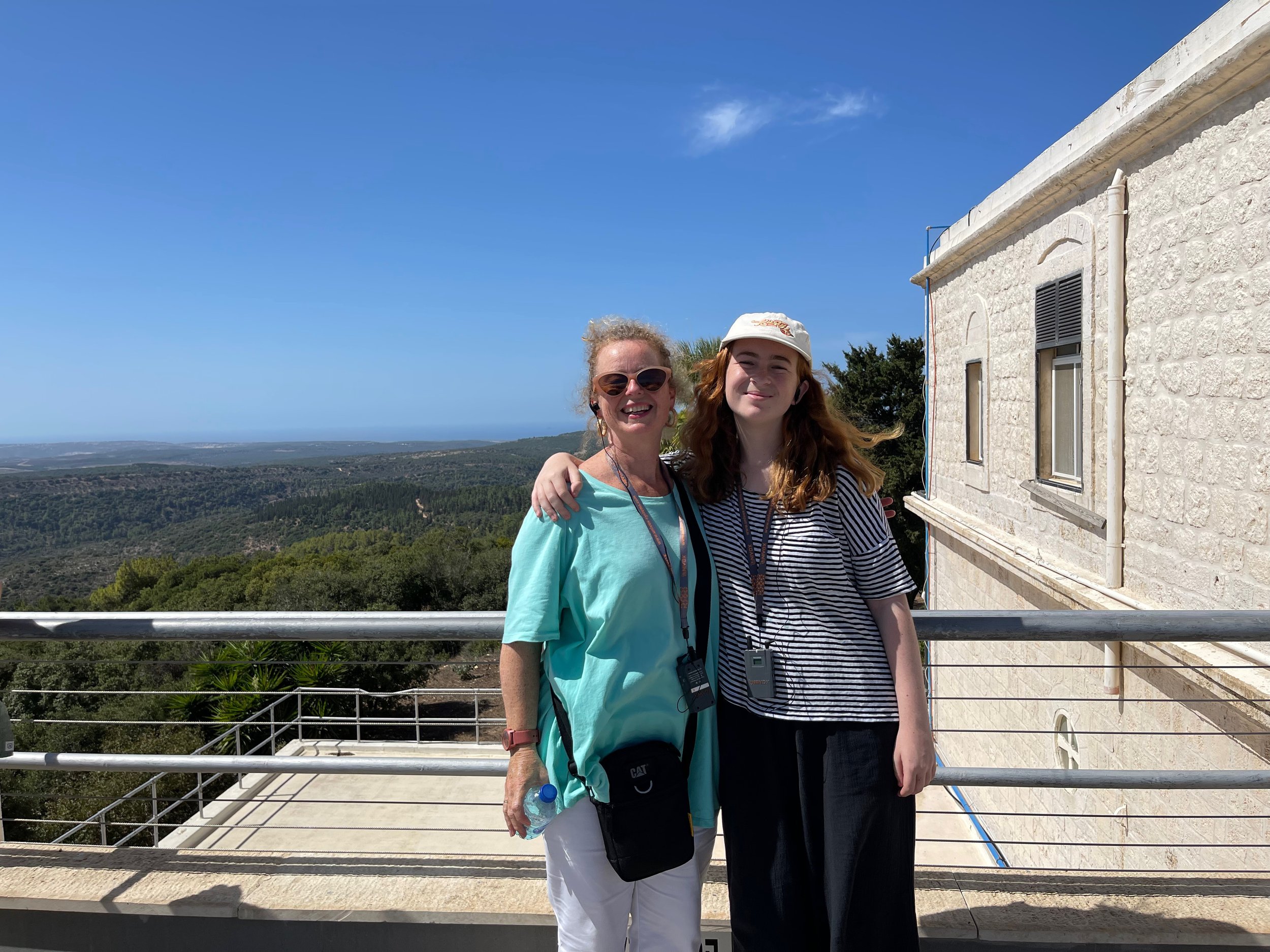Layer Upon Layer Upon Layer
There was a hum of excited anticipation in the air this morning as we downed our toast and cereal. We were swapping our rural digs for a high rise hotel in the big smoke and turning towards Jerusalem.
As usual, we would be making a few pit stops on the way and even though we’ve each been issued with a detailed itinerary, listing place names and locations, the joy of this tour is not really knowing what to expect and being blown away by what unfolds at each stop. Fadi’s brain is so packed with interesting facts and figures, the man is a guidebook on legs.
Our first stop was Megiddo, (called Armageddon in Greek) where the who’s who of the ancient world rubbed shoulders with one another and built lots of things. This place staged countless important battles dating back thousands of years and seeing the view from the top of Mount Megiddo - vast patchwork-quilt plains across the valley, surrounded by parched grassy mountains - it was easy to imagine why is would be the perfect place for some toe-to-toe combat action. Napoleon callied it: “the most natural battleground of the whole Earth.” Of course Armageddon is famous for being the future biblical destination, symbolically or otherwise, for the ultimate climactic battle between good an evil.
We’ve learnt that a “tel” is an archaeological site with multiple layers of civilisations built on top of one another like a huge historical Danish pastry; layer upon layer upon layer. The Miggido Tel has a mind- boggling 30 layers, meaning 30 separate cities - each with its own gates, stables, fountains, roadways and neighbourhoods - have existed here. This civilisation sandwich needs to be treated with the utmost care, patiently peeling back a section at a time and combing through the remains for clues as to who may have lived here. It was surreal to be walking through stone city gates believed to be built by the famously wise and wife-accumulating King Solomon. It’s a wonder he had much downtime with all those 700 wives of his. He’d have needed a whole village just to house his own family.
Back in the 1930s, keen bean archaeologists from the University of Chicago, came in like a bull at a gate and excavated Megiddo with zeal and speed, uncovering valuable information about the place but also possibly disturbing certain layers. The current rule in Israel is that you can only dig 11cm at a time. Slow and steady wins the race.
Apart from meandering around the surface of the palm-treed tel, we got to descend the steep 183 steps to the coolness of Megiddo’s still-intact water tunnels and also got to spy an expansive underground stone silo. So ingenious.
Back to the comfort of our airconditioned bus, we hurtled towards our next point of interest, Mount Carmel. This mountaintop is famous for the biblical showdown between Elijah and the pagan prophets of Baal. We entered the grounds of the Carmelite monastery, with its quirky, if not slightly daggy, gardens of potted geraniums, wishing wells and funny little statues. In the shade of the cool garden, Barbara did a dramatic reading of the epic event that took place here, (1 Kings 19) and Dean expanded the story for us before we ascended to the roof of the church for sensational panoramic views all the way to the Mediterranean Sea.
They love a good buffet here in Israel and our lunch spot had a comprehensive selection of dishes on offer. They’d really tried to bring the outside in, with half the restaurant floors clad in fake grass; a couple of rocking chairs thrown in for good measure. The food was far superior to the decor and was doing a roaring trade.
This morning when we’d packed up our rooms, we’d stowed all our luggage under the bus and I’d accidentally packed away my camera, so had to rely on pics from my iPhone today. Anyone who’s tried to take photos using a phone in the sun will know, often you can’t see the screen at all and are shooting more or less blind. I had inadvertently switched to selfie mode and unfortunately, most of my photos are close-ups of my own sweaty dial, pained concentration etched across my features and minimal scenery in the background. I could be anywhere.
Camera rectified, i did manage a few right-way-round snaps as we enjoyed a beautiful walk around Caesarea Philippi, right on the shores of the Mediterranean. Once again this area was rich with history and awash with biblical references. The Apostle Paul was imprisoned here and actually set sail for Rome from the major trade port that Herod built here. Herod also had a lavish palace with an Olympic-worthy, freshwater swimming pool positioned right on the beach. I mentioned to Fadi that there was a nice pub on the point and he told me it had been built by Crusaders and was a cool 800 years old. That’s a lot of parmies and pints.
Checking out the copious ruins and recreated theatre by the beach was hot work and we refreshed with the delicious Italian gelato Deb and Dean had remembered from their last visit and had been the carrot on the stick promised as an end to our visit today.
Bunkering back down in the bus, we had a fun singalong and when Jerusalem was looming large on the horizon, sang the very apt and moving Cityalight song that bear’s the city’s name.
We gathered at a lookout to view the striking golden Dome of the Rock, standing out like a (golden) sore thumb, nestled in amongst the predominantly white landscape of buildings in Jerusalem stone.
The culturally and religiously diverse city of Jerusalem, described by Fadi as “complicated” is in the midst of the Jewish festival, Sukkot, also known as the Feast of Tabernacles. Jews light candles, perform Kiddush (a ritual ceremony of prayer and blessing over wine) and eat challah, a special bread dipped in honey. The festival is to commemorate the Jews’ wanderings en route from Egypt to the land of milk and honey, when they camped out in tents. They are remembering the way God protected them and brought them out of Egypt. For this reason, the custom is to erect some sort of tent, where you’ll eat your meals during the period of the festival.
Square canvas tents, adorned with palm fronds and sometimes with thatched rooves, are popped up all over Israel but here in the capital, against the bright lights of the big city, they look peculiar, with some even set-up on unit balconies. Our hotel has cordoned off a section of its al fresco restaurant to look like a tent and has installed a temporary shelter of thatch above it. Only Jewish patrons are allowed in.
We have also arrived in Jerusalem on Shabbat, otherwise known as the Sabbath, the day God traditionally designed for us to lay off work, put our feet up and generally chill. The Jews have taken the “lay off work” to the extreme, meaning that even pushing an elevator button could be considered “work”. For this reason, in our hotel, the elevators stop at Every. Single. Floor. (We took advantage of the stairs.) No-one cooks on the Sabbath either so at dinner time, when the chef says, “here’s a little something I prepared earlier”, he really means it! Ravenous from the day, I scooted over to the carvery and spotted what I thought was delicious-looking pork roast. Salivating at the prospect of getting some of the proverbial on my fork, I asked the chef - “Oooh is this pork?”. He looked quite miffed and stated emphatically that NO, it was NOT pork. It was turkey. I later realised that pork isn’t exactly a fan favourite for the Orthodox Jews. Oops.














































